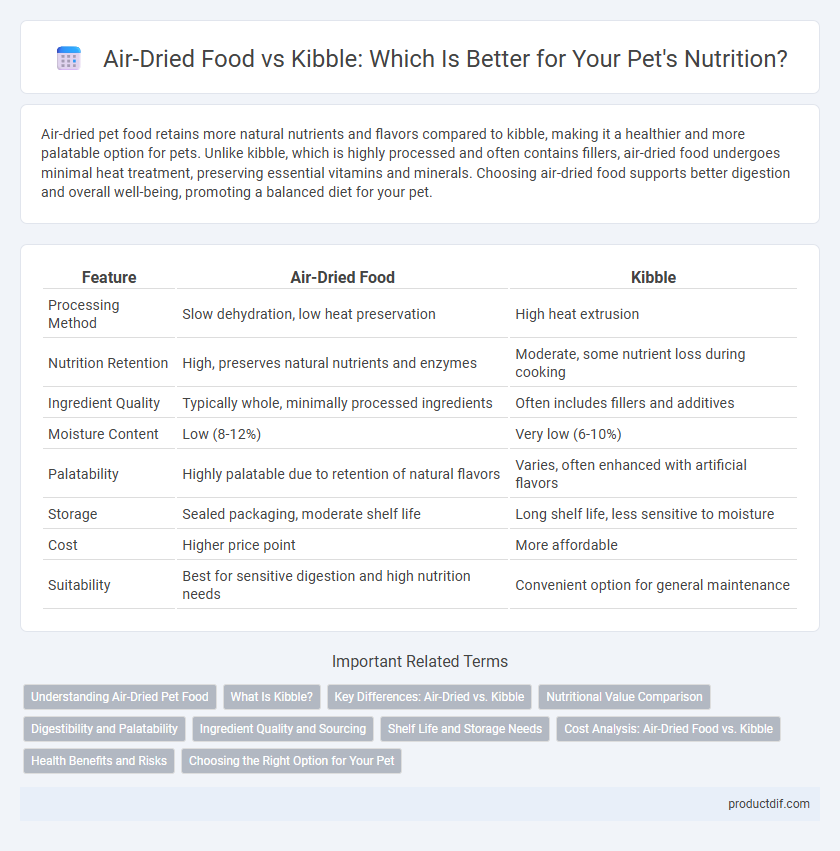Air-dried pet food retains more natural nutrients and flavors compared to kibble, making it a healthier and more palatable option for pets. Unlike kibble, which is highly processed and often contains fillers, air-dried food undergoes minimal heat treatment, preserving essential vitamins and minerals. Choosing air-dried food supports better digestion and overall well-being, promoting a balanced diet for your pet.
Table of Comparison
| Feature | Air-Dried Food | Kibble |
|---|---|---|
| Processing Method | Slow dehydration, low heat preservation | High heat extrusion |
| Nutrition Retention | High, preserves natural nutrients and enzymes | Moderate, some nutrient loss during cooking |
| Ingredient Quality | Typically whole, minimally processed ingredients | Often includes fillers and additives |
| Moisture Content | Low (8-12%) | Very low (6-10%) |
| Palatability | Highly palatable due to retention of natural flavors | Varies, often enhanced with artificial flavors |
| Storage | Sealed packaging, moderate shelf life | Long shelf life, less sensitive to moisture |
| Cost | Higher price point | More affordable |
| Suitability | Best for sensitive digestion and high nutrition needs | Convenient option for general maintenance |
Understanding Air-Dried Pet Food
Air-dried pet food retains more natural nutrients and enzymes by using low-temperature drying processes, which preserves the food's original flavor and texture better than traditional kibble. This method results in a highly digestible product with less artificial preservatives and fillers, promoting improved pet health and digestion. Compared to kibble, air-dried food often contains higher-quality protein sources and maintains moisture, making it a premium option for pet nutrition.
What Is Kibble?
Kibble is a type of pet food made through a process of extrusion, where ingredients like meat, grains, and vegetables are cooked under high heat and pressure before being shaped into small, dry pellets. This method not only extends the shelf life of the food but also allows for precise nutrient formulation to meet pets' dietary needs. Compared to air-dried food, kibble is more affordable and convenient for storage but often contains more fillers and preservatives.
Key Differences: Air-Dried vs. Kibble
Air-dried pet food retains more natural nutrients and moisture compared to kibble, which undergoes high-heat extrusion leading to nutrient degradation. Air-dried formulas typically contain higher protein content and fewer fillers, making them easier to digest and more palatable for pets. Kibble offers longer shelf life and convenience but may require added preservatives and less real meat content compared to air-dried alternatives.
Nutritional Value Comparison
Air-dried pet food retains more natural nutrients and enzymes compared to kibble due to its low-temperature dehydration process, preserving essential vitamins and amino acids. Kibble undergoes high-heat extrusion, which can degrade heat-sensitive nutrients, often necessitating synthetic vitamin supplementation to meet nutritional standards. Studies show air-dried diets typically offer higher bioavailability of proteins and fats, promoting better digestion and nutrient absorption for pets.
Digestibility and Palatability
Air-dried pet food offers superior digestibility compared to kibble, preserving more natural nutrients due to its low-temperature drying process. Palatability is enhanced in air-dried diets as they retain the original flavors and textures of raw ingredients, appealing to even the most finicky pets. In contrast, kibble often contains fillers and undergoes high-heat processing, which can reduce nutrient availability and flavor intensity, impacting both digestibility and taste preferences.
Ingredient Quality and Sourcing
Air-dried pet food often contains higher-quality, minimally processed ingredients sourced from whole meats and organic vegetables, preserving essential nutrients and natural flavors. Kibble typically uses more fillers, by-products, and heavily processed ingredients to reduce costs, which can impact nutrient density and digestibility. Premium air-dried formulas prioritize clean sourcing, supporting transparency and better ingredient traceability compared to many mass-produced kibble brands.
Shelf Life and Storage Needs
Air-dried pet food typically offers a longer shelf life than kibble due to its low moisture content and minimal processing, which helps preserve nutrients without refrigeration. Kibble requires airtight storage to prevent moisture absorption and rancidity, often needing cool, dry conditions to maintain freshness. Proper storage of both types extends their usability, with air-dried food generally less prone to spoilage and nutrient degradation over time.
Cost Analysis: Air-Dried Food vs. Kibble
Air-dried pet food typically costs more per pound than kibble due to its low moisture content and preservation process, which retains higher nutrient density and flavor. While kibble offers affordability and convenience with longer shelf life, it often contains fillers that lower production expenses. Evaluating cost-effectiveness involves considering portion size, nutritional value, and the potential for reduced feeding quantities with air-dried options.
Health Benefits and Risks
Air-dried pet food retains more natural nutrients and enzymes compared to kibble, supporting better digestion and enhanced immune function. Kibble, while convenient and shelf-stable, often contains fillers and preservatives that may contribute to allergies and obesity in pets. Choosing air-dried food can reduce the risk of nutrient degradation and promote overall health by maintaining higher protein quality and moisture content.
Choosing the Right Option for Your Pet
Air-dried pet food retains more natural nutrients and moisture compared to kibble, promoting better digestion and hydration for your pet. Kibble offers convenience, longer shelf life, and cost-effectiveness while providing balanced nutrition. Assess your pet's health needs, dental condition, and lifestyle to determine whether nutrient-rich air-dried food or practical kibble best supports their overall well-being.
Air-dried food vs Kibble Infographic

 productdif.com
productdif.com